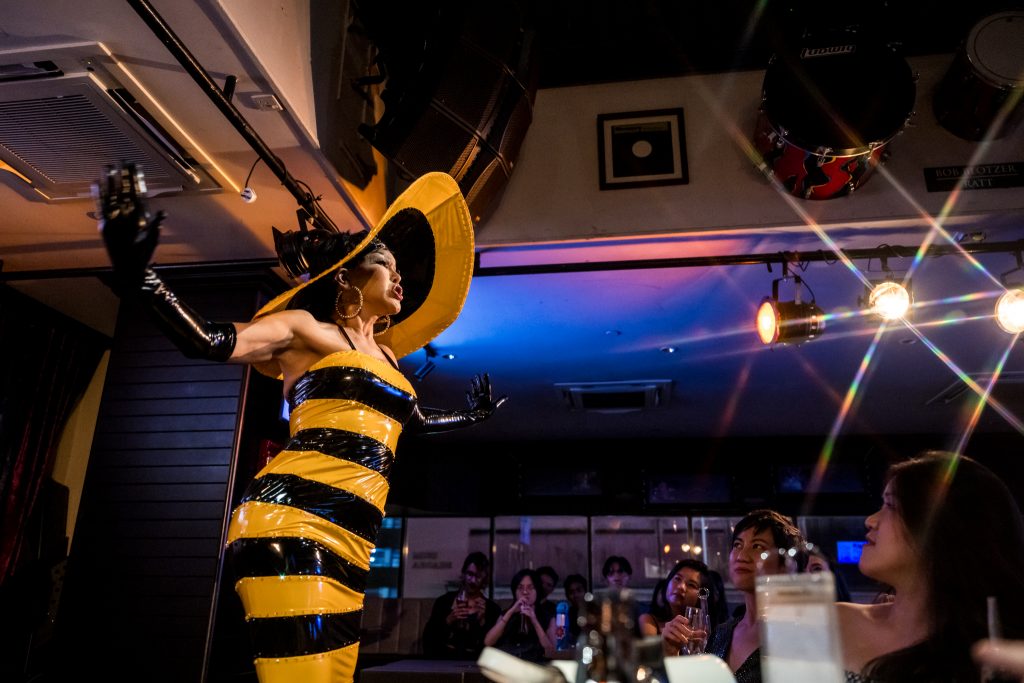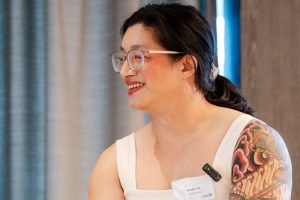All images courtesy of Kak Nina Boo unless stated otherwise.
“She’s so old, she’s practically Sang Nila Utama’s girlfriend!”
56-year-old drag queen Kak Nina Boo, or Kak Nina, tells me that these are the usual opening quips that precede her entrance onto the stage.
ADVERTISEMENT
I bristle at the comment’s potential sensitivity. But Kak Nina is unperturbed at all the jabs at her age. She lets out a hearty chuckle and assures that she actually considers these remarks comedic gold.
“It’s funny. When I’m backstage hearing these, my laughter is the loudest.”
In retrospect, I’m not surprised. Kak Nina’s response matches the grace she exudes through my computer screen. Bare-faced, with a blue silk robe draped around her, Kak Nina is a gentle portrait of ease.
When it comes to drag queens, the stereotypical image I’m accustomed to is one of theatrical extravagance. But Kak Nina is mellow—almost understated. It’s evident that time has softened out any rough edges from her youth.
Kak Nina, who started transitioning into a woman in 1981, isn’t exactly the youngest member to grace the stage. Every Saturday, she stars as a performer under RIOT!, a weekly affair hosted at Hard Rock Cafe. She has close to 30 years of tenure in the industry and estimates that she’s at least 15 years older than the average queen.
It’s 10:30 PM, and the stage at Hard Rock Cafe is flickering to life. New queens burst onto the platform, wigs bouncing as the latest pop hits reverberate through the air behind them. Fresh-faced and effervescent, they are pockets of boundless, untapped potential.
Kak Nina waits backstage. The screams are deafening. A breath escapes her lips. In an industry that swaps performers faster than underwear, how does a seasoned 56-year-old respond to the intimidating terror of youth? Who has the years in show business moulded Kak Nina into?

A Dog-Eat-Dog World
As established as she is now, Kak Nina’s fledgling showbiz days couldn’t be more different. It was like a headfirst plunge into uncharted waters.
“I’m the kind of person who usually never says no to whatever people ask me. The point for me is to just do it. If I get it right, why not carry on? And if I don’t, at least I’ve tried, you know?”
So when her friend, a member of dance crew The Tiffany Dollies, approached her to join the group as a backup dancer in 1997, she didn’t hesitate. Despite no prior dance training, she stayed in the group for three to four years, performing alongside other trans women for corporate shows.
The turning point came in 1999 on the anniversary of Boom Boom Room—Singapore’s first drag queen cabaret nightclub—when her crew nabbed an opportunity to perform. And when Boom Boom Room’s artistic director invited her to join them, she jumped at the chance.
She may have made it to the iconic cabaret, but her days there were an entirely different uphill battle. Forget the luxury of YouTube beauty guru tips and online dance classes; the internet was still an abstract concept back then.
ADVERTISEMENT
“[The performers] are not there to train you. You have to be street-smart and look and learn.” Survival in the spotlight meant mastering skills on the fly, relying solely on quick wits to emulate the theatrics of other performers.
“What kind of dress do I wear to make myself look good? What kind of wigs do I wear? I had to learn all these by looking and copying the other performers there.”
A frown crosses her face as she narrates the lack of guidance she received. Despite her conspicuous greenness, her fellow performers weren’t exactly eager to show her the ropes. She struggled, and they were determined not to let her forget it.
“Maybe because it was more like a competition. It was really about survival of the fittest.”
“We had to learn four to five dances back then and immediately perform them the next day. There was no hand-holding If you couldn’t follow along—only comments like ‘Why can’t you do this? Why do you only do that?’ ”
In the wee hours of the night, long after the curtains had closed, she would hunch over her desk, remnants of cut-up t-shirts and pants strewn over her room. There, stitch by stitch, she fashioned make-shift costumes out of her wardrobe.
Costumes came with a hefty price tag, and as a budding performer, she struggled to sustain herself financially. “When I first started, I didn’t have the base—it was all very new.”
Tucked away in the fluorescent white walls of an office cubicle, she worked a part-time customer service job paying a measly $4.50 an hour to make ends meet.
Some fellow performers, perhaps feeling sorry for her, gave her hand-me-downs—albeit only if they deemed them too outdated for their tastes. As for make-up, she had to rely on her colleagues, though their ‘goodwill’ didn’t always come without the accompanying snide comments or distasteful side-eyes.
“They will pass you [the make-up] with that look like, ‘Can’t you afford this?’ There was a lot of humiliation and degradation, but you just had to swallow it down. I kept telling myself that I needed to survive this. It’s a stage everyone has to go through in show business.”
A Series of Closed Doors
Kak Nina is solemn as we converse, her tone low. Even through the screen, a perceptible tinge of sorrow outlines her words when she recalls the past. Unexpectedly, she tells me that drag was never her true calling—her passion has always been theatre.
This passion was realised in the ’80s when she landed her first play at the prestigious National Theatre. She was naturally elated—the opportunity felt like the 15-year-old’s big break onto the crimson stage. It wasn’t until she learned she’d been cast as a shirtless warrior that her excitement began to dim.
It may seem like a harmless request. But, at the time, unbeknownst to the director and her fellow cast members, Kak Nina had started transitioning into a woman the year prior. Her body was starting to change; she was beginning to develop breasts.
“Transitioning is not easy,” She laments. “During that time, there were no LGBTQ+ communities. It was only about survival. I didn’t know if people would accept me, much less whether I could play the warrior role well.”
It was scary enough for a young boy to reckon with an evolving body, much less do so whilst in the limelight. After all, baring her body wasn’t simply about revealing some skin; it was also about unveiling her identity in a world that brandished pitchforks and snubbed transgender women.
Her devotion to the Islamic faith didn’t make the process easier. Deviating from her assigned gender was deemed a sin In the eyes of her religion.
The disapproval from those in her professional circles and acquaintances was palpable. Things reached a tipping point when her desire to wear a telekung (a prayer garment donned by women) was met with reproachful remarks and vehement whispers.
“People would be interrogating me with questions like ‘You were born a male, why are you wearing that? What are you doing?’ It was hard to come to terms with this phase of my life when people around me were always questioning.”
No longer feeling safe in the spotlight, she eventually quit the play and isolated herself from her friends and family.
Dragged Through The Mud
Kak nina physically distanced herself from theatre, yet the fervent desire to perform never left. An inevitable string of insecurities followed that desire to perform.
As she recounts the past, from her gender transition to her time at Boom Boom Room, the motif of not feeling beautiful consistently crops up. Throughout our interactions, I quickly realise that questions alluding to her physical appearance are the hardest to tackle; unspoken cadences of uncertainty linger as we speak.
It seems contradictory, paradoxical even, to envision drag queens like Kak Nina battling insecurities. After all, it’s a profession where you flaunt your beauty, and get paid for it.
Kak Nina’s explanation is simple and heartbreaking: “I was a boy wearing make-up, wearing a bra and shorts. You don’t feel feminine; you feel like a man.”
Immersed in the glitzy world of coiffed wigs and sequin-embellished dresses, she couldn’t escape the relentless loop of self-comparison. She could barely feel at ease in her skin. Witnessing fellow queens who radiated beauty only reminded her of the standards she couldn’t measure up to.
Regardless of how vibrant and diverse it is, even the drag scene can’t evade the rigid confines of beauty standards. Kak Nina adds that lead roles were reserved for those who embodied the tall, slim, and statuesque archetype—attributes that, according to the judgements she faced, eluded her.
While other queens sauntered down catwalks, evocating poses from every conceivable angle, she was woefully consigned to background roles. “I couldn’t be the main lead, so I was considered a backup performer. They would tell me that I wasn’t tall enough or pretty enough,” she explains. “I felt like I didn’t belong.”
She wound up taking dance classes to set herself apart, revealing that jazz and ballet were among the many genres she gladly dove into.
And it worked. Over time, her dance skills distinguished her from other queens, and she gradually carved a niche for herself—performances set to the tunes of icons like Britney and Janet Jackson. There’s an unmistakable glint in her eyes when she proudly declares that for dance numbers, she eventually got to be the lead.
It may sound like the perfect feel-good underdog story. But disparaging comments like these are hard to shed. It’s even harder when you’ve been pummelled by them for years.
Despite the applause she now commands from co-performers and audiences for her glamorous persona, Kak Nina admits to having difficulty embracing it. When probed on whether she agrees with their perception, she hesitates.
A brief silence hangs in the air. Then, another pause. It’s almost as if she’s afraid of sounding too self-assured.
“I think I was battered in my brain during my time that ‘You’re not beautiful. You’re not tall. You cannot do this number.’” A half-hearted chuckle follows.
“I always try to lean on my comedic side. I feel like I’m more goofy. Pretty and glamorous? I don’t see it.”
A Shifting Beneath Her Feet
Back in Kak Nina’s twenties, during her inaugural strides onto the drag stage, social media had yet to be conceived—few would have understood its concept. As she later describes, adapting to this was one of the most challenging shifts.
“Maybe I was born from a different generation. In my time, I worked hard to be noticed, to be known, and to be popular. Now, you just have to be pretty on social media, and then, 2,000 followers!”
Success used to depend on one’s performance skills. To make it big, a queen had to have the quick-wittedness of a stand-up comedian and the physical prowess of an athlete, all neatly packaged under the glitz and glamour. Now, at least in Kak Nina’s view, it’s been reduced to which performer looks the best.
Plus, in today’s fame game, riding the waves of viral trends and catchy TikTok sounds has become a cheat code to internet stardom.
Nonetheless, Kak Nina eventually relents. As passionate as she is about her craft, even she can’t deny the necessity of keeping up with the times. “My friend called me a sour grape.” She laughs. “But I guess I have to understand their point of view. I’m surrounded by new queens every day, so it’s just like, okay, okay, let me try to understand this.”
At the very least, social media has paved the way for camaraderie. Tensions give way, and friendships emerge. “The queens nowadays connect through social media and then get together. In my time, you had to go home after performances.”
“Now, they can still dress, go out, and party—It’s good! There weren’t as many opportunities to interact in the past. Our stage costume was like a uniform. It was strictly professional,” she explains.
Money No Enough
The industry may have gotten more positive since Kak Nina’s earlier days, but it doesn’t come without its share of growing pains.
Drag is now more popular. And as it inches closer to the mainstream, more drag queens have sprung up and entered the scene. However, more fish in the sea also means Kak Nina rakes in less.
Perhaps drag simply isn’t as novel as it used to be, or maybe it’s that queens are offering their performances at lower rates. Regardless, Kak Nina shares that she’s making 80 percent less than her prime—a weekly four-figure earning, as she candidly reveals.
It might be a massive dip in earnings, but Kak Nina isn’t all that bothered. “The events have the right to choose. If someone says that I’m expensive, then okay, I’ll recommend someone else,” she coolly adds.
Her years of experience have allowed her to carve out a name for herself. Besides public performances, she now relies on corporate gigs—which, according to her, pay significantly more anyway.
Ultimately, the entertainment industry is unforgiving, and price competition is a natural extension of show business. Kak Nina says she doesn’t want to “take it to heart anymore”.
Come As You Are
As Kak Nina traces her career trajectory, it’s evident that the theme of hardships is a recurring one. It makes me wonder why she’s stuck around in the industry for as long as she has. She may love show business, but show business certainly hasn’t always been kind to her.
When asked, a certain resolve permeates Kak Nina’s voice.
“Honestly, it just boils down to this mentality: If I am asked to do something, I just need to do it. At that particular moment, it was about proving to people that I could. I did not want them to look down on me because they already did.”
If she holds any grievances or petty grudges, it isn’t betrayed by her voice. Kak Nina decides this part of her has frayed with time; at the very least, she hopes that’s one thing her age has afforded her—a quiet, budding self-assurance.
“When the new queens perform before me, and the crowds are screaming, I think to myself: how can I top this? She’s like 21, and I’m 56,” she remarks, incredulous. “But in the end, it’s always like, let’s just do me, you know? I don’t mind if there’s no applause and nobody knows me as long as you can see me perform.”
“Now, I just want to be known as someone caring and not afraid to share their knowledge and experience with the new generation. That’s who I want to be—a beacon of light for the new drag queens.”
A Life on Stage
Considering her age, I ask if she has ever feared losing popularity. She smiles and confesses that she’s been in this quandary every year since she turned 40.
“Every year, I think this may finally be the year I hang up my heels and retire like my old co-performers. But then, I get a call for a performance next year, and the cycle repeats.”
In her youth, Kak Nina would clamour from stage to stage, always eager to prove something of herself. Now, the word ‘content’ comes up much more.
For her, performing on stage goes beyond receiving acclaim. It’s also the act of telling a story, of bringing someone into her world. “When I’m on stage, I get to forget who I am. When the spotlight shines on me, the insecurities lie backstage.”
At least, that is what Kak Nina tells me she wants her performances to be: an act of losing yourself, if only momentarily, in something larger than you are.
And, in a way, isn’t that what we are all yearning for? That singular, fleeting moment when we can finally cast away the unbearable weight of our being? After all, drag is meant to be larger than life. And as her worries fall away on the wooden platform, so do her audiences’.
If anything, Kak Nina is simply grateful that she’s still in demand. And when the applause naturally dies out, so will her time in the industry.
But that’s still a long time away. For now, the stage beckons—there are still Mariah Carey songs to sing and applause to be heard.
The lights dim. The crowd roars. Silver microphone in hand, she steps past the curtains. This time, the screams are reserved for her.






